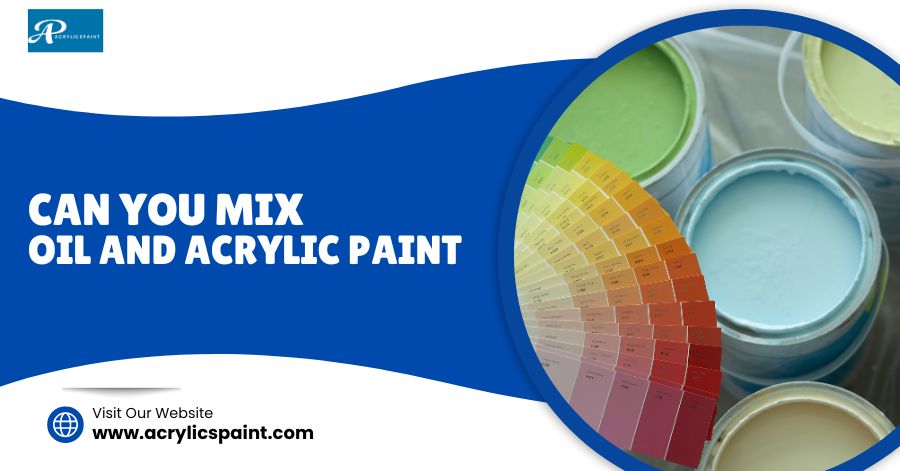Can you mix oil and acrylic paint? When painting, artists often explore different mediums to achieve their desired effects. Among the vast options are oil and acrylic, offering distinct characteristics and techniques. But can you mix oil and acrylic paint? Let’s explore this question and understand the similarity and best practices for combining these two mediums in your artwork.
Oil vs. Acrylic Paints
Oil and acrylic paints stand on opposite ends of the spectrum regarding their chemical composition and drying properties. As the name suggests, oil paints are oil-based, while acrylic is water-based. This fundamental difference is crucial to understand when considering mixing the two mediums.
Imagine trying to mix oil and water—they do not blend. Similarly, attempting to mix wet oil and acrylic paints on your palette will result in frustration. Not only will they fail to blend, but their application onto your canvas will lead to degradation over time. The chemical reaction between oil and acrylics degrades the quality of your painting, rendering your artistic efforts futile.
However, you can still incorporate oil and acrylic paints into your artwork. Understanding the limitations and best practices is key to achieving successful results.
Can You Mix Oil and Acrylic Paint?
The similarity between oil and acrylic paints has long been debated among artists. While some believe mixing the two can lead to unwanted results, others love doing it even though it’s challenging. Also you can read about Can You Mix Acrylic and Latex Paint?
Using Oil and Acrylic Paints Together
Mixing oil and acrylic paint is possible, but it could be more desirable; instead, you can use both mediums side by side. Acrylic paints can be applied first, as they dry relatively quickly and serve as an excellent base layer. After allowing the acrylic paint to fully dry, you can safely paint over it using oil paints. This approach will enable artists to leverage each medium’s unique properties while ensuring the artwork’s longevity.
Conversely, it is crucial to avoid painting acrylics over oils. The acrylic paint will struggle to adhere to the oil paint surface, resulting in flaking and ultimately compromising the integrity of the painting. Therefore, always remember the golden rule: oil over acrylic, never acrylic over oil.
Despite the temptation to experiment, mixing wet oil and acrylic paints is not worth the risk. Instead, explore alternative techniques such as layering or glazing to achieve desired effects without compromising the quality of your artwork.
Truth About How to Tell the Difference Between Oil and Acrylic Paintings
Several factors come into play when distinguishing between oil and acrylic paintings. Firstly, observe the texture and sheen of the paint surface. Oil paintings tend to have a richer texture and a lustrous finish compared to the smoother surface of acrylic paintings. Additionally, consider the drying time oil paints are slow-drying mediums that allow for smooth blending, while acrylics dry rapidly, making them ideal for quick work or layering.
Look for differences in surface texture, glossiness, and brushstroke characteristics. Consider the aging properties of the paint, as well as any varnishes or surface treatments applied. Inspecting the paint layers and underlayers can also provide clues about the type of paint used. Solvents or chemical tests may be necessary for accurate identification, but consulting with experts can offer valuable insights.
Tips for Oil and Acrylic Painting Together
Still, if you want to mix both paints, you can try the following tips for better results.
- Choosing a suitable surface for painting is crucial when working with mixed media.
- Consider the absorbency and texture of the canvas or board and prime surfaces to ensure proper adhesion.
- Start with a Plan: Have a clear vision of integrating oil and acrylic paints into your artwork before you begin.
- Use Compatible Materials: Ensure that the mediums, brushes, and surfaces you use are compatible with both to prevent issues with adhesion and drying.
- Layer Wisely: Apply acrylic as a base layer for quick drying, and then add oil paints on top for blending and texture.
- Experiment with Mediums: Explore different mediums, such as gels or drying retarders, to adjust the drying time and consistency of oil and acrylic paints.
- Blend Carefully: Be mindful of the drying times of each paint type when blending, as acrylics dry quickly while oils take longer to dry.
- Allow for Drying Time: Give each layer of paint sufficient time to dry before adding additional layers or details to avoid smudging or muddying the colors.
- Test on Small Scale: Before committing to a larger piece, experiment with mixing oil and acrylic paints on a small canvas or surface to test the techniques.
- Protect Your Workspace: Use a palette knife or separate palette to mix oil and acrylic paints to avoid getting dirty with your supplies.
- Clean Brushes Properly: Clean your brushes thoroughly between paint changes to prevent cross-contamination of oil and acrylic paints.
Techniques for Mixing Oil and Acrylic Paint
Before mixing oil and acrylic paints, it’s crucial to take precautions to ensure safety and optimal results. Wear appropriate protective gear, ventilation, and a proper workspace setup. Consider each medium’s desired effects and advantages when layering oil and acrylic paints. Layering techniques can add texture and depth to your paintings, creating unique visual interest.
Blending methods are crucial to achieving desired effects when mixing oil and acrylic paints. Experiment with wet-on-wet and wet-on-dry techniques to create seamless transitions between colors and textures. Maintaining color integrity while blending is essential, so be mindful of how different pigments interact.
Conclusion
In conclusion, Can you mix oil and acrylic paint? While mixing oil and acrylic paints may spark curiosity, it’s essential to understand their nature and best practices to avoid detrimental effects on your artwork. By adhering to the guidelines outlined above, using oil over acrylic, and refraining from mixing wet paints, artists can effectively incorporate both mediums into their creative endeavors, unlocking a world of possibilities in their artistic journey. Happy painting!















